Pseudotachylyte is fault glass. It’s rock that got melted due to frictional heat generated “in the heat of the moment” as an earthquake occurs, then froze before having the chance to crystallize. My friend and colleague Christie Rowe likes to call pseudotachylyte a “fossil earthquake,” and I think that’s a lovely way of thinking of it. Here’s an example I saw Thursday afternoon, in the South Mountains of Phoenix, Arizona:
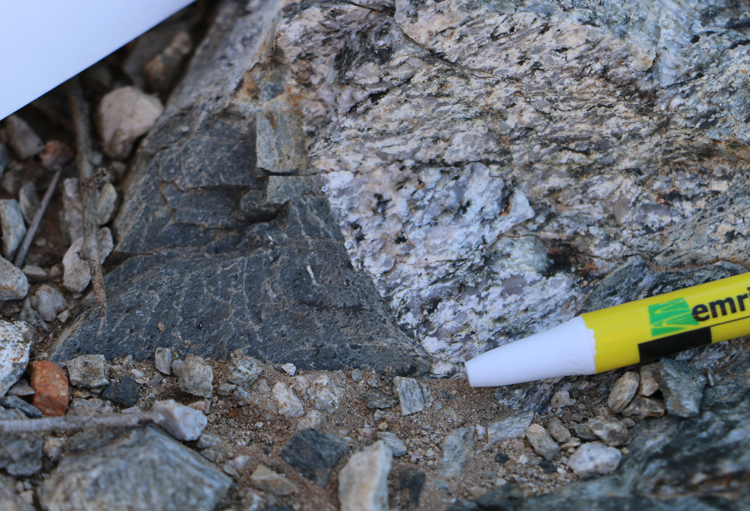
Annotated:

The South Mountains are a metamorphic core complex: a large sort of structure that is moderately common in the mountains of southwestern Arizona, but also present in other areas of the world. These metamorphic core complexes are characterized by a dome-like blob of exhumed rock rising up, and overlying rocks slipping off the top. The rocks that pooch upward in the middle of the complex go from deep, hot conditions to shallow, colder conditions. The deformation they experience thus starts off ductile, and then transitions to brittle as they make their way up to the surface.
At Dobbins Lookout in the South Mountains, you can see this for yourself. There, a Tertiary-aged granite pluton shows mylonitic fabric with a dominantly horizontal foliation and an east-west-trending lineation, cross-cut by veins of pseudotachylyte. Here is an example:
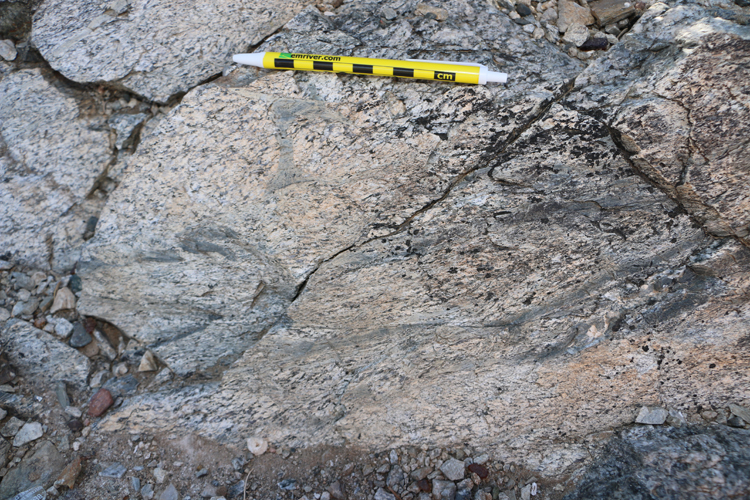
…Annotated:
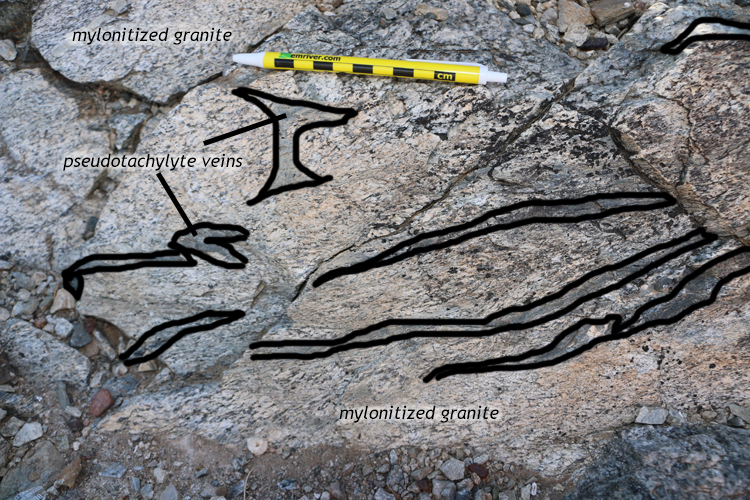
The principle of cross-cutting relationships reminds us that when one geologic unit or structure cuts across another one, the cutter must be younger. At this site, the ductile fabric of the mylonite is transected by the veins of brittle pseudotachylyte. This shows in miniature the structural imprint of the granite’s journey upward through different deformational conditions through time.
Here is another outcrop showing the same sort of thing:

…Also annotated:
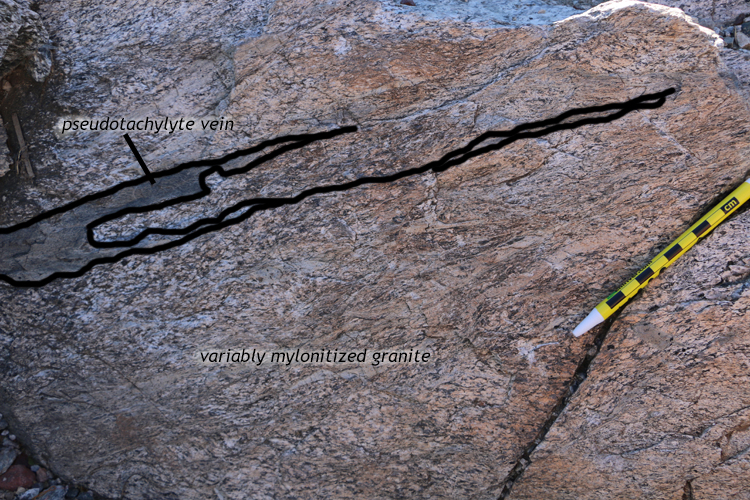
Now check this out:

Do you see what I see?
Let’s zoom in…
Note the “sideways diapir-shaped” set of concentric bands within a small pocket of pseudotachylyte –
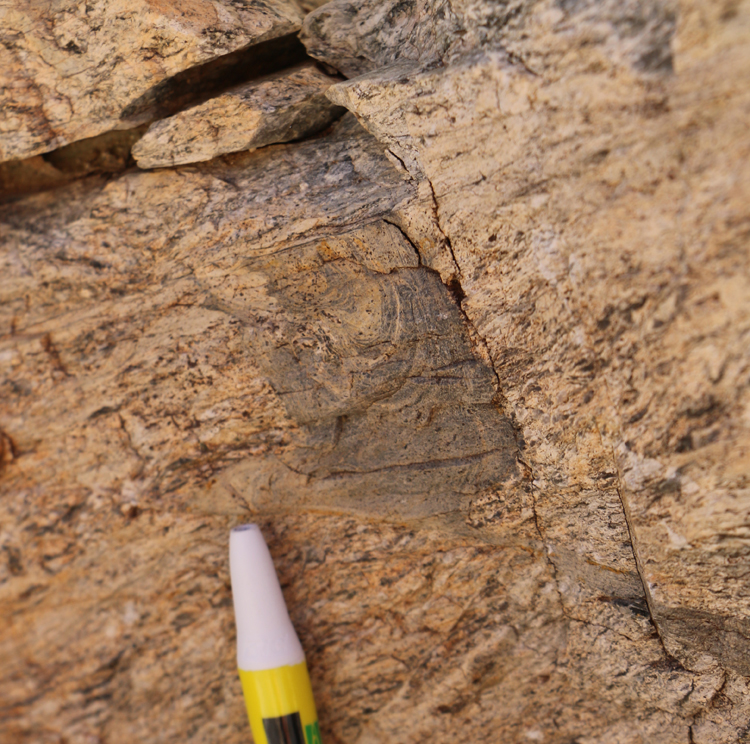
It almost looks like a thumbprint, or a surficial deposit of mud. But it’s not! It’s part of the rock.
It struck me that this could be flow banding within the melt, recording the expansion of the earthquake-frictionally-melted rock into a ~square dilational pocket, as the block of granite to the left slid to the left, relative to the block of granite to the right, something like this:
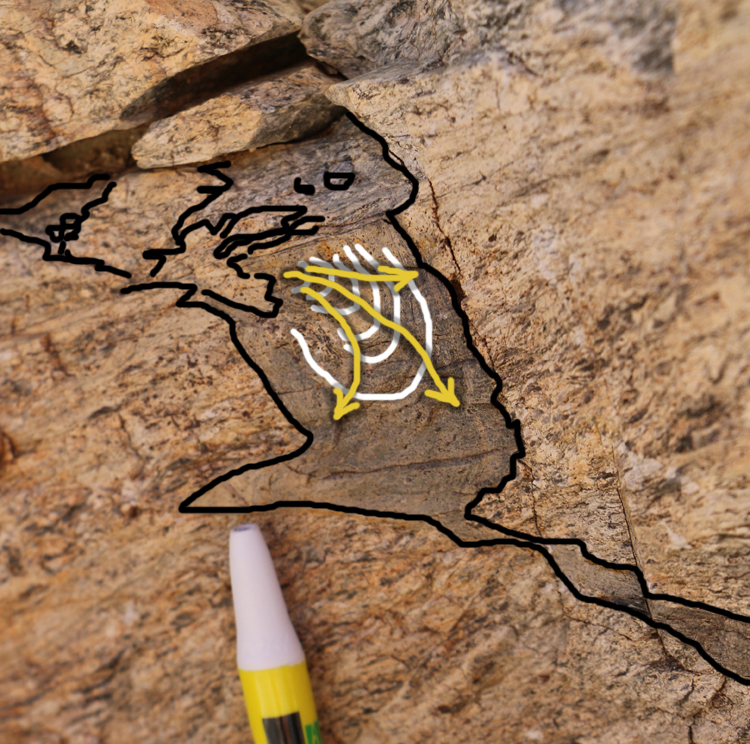
In the annotation, the pseudotachylyte vein’s contact with the mylonitized granite is outlined in black, the concentric flow banding is traced out in white, and my interpretation of flow direction is shown with the yellow arrows.
What do you think? I thought this was very cool. I’ve seen flow banding before in igneous rocks, both felsic and mafic, volcanic and plutonic, but this was my first time seeing it in pseudotachylyte. I ran my interpretation by Steve Reynolds of Arizona State University, the geologist who mapped out these rocks and first successfully interpreted them as a metamorphic core complex, and he concurs, so therefore I know it has to be legitimate! 🙂
I first saw these rocks in January on a field trip that Steve led for the Structural Geology and Tectonics Forum, but I didn’t have nearly as much time to explore the site then as I did this past Thursday, when I was lucky enough to find myself in Phoenix with a free afternoon, and good company in the person of my former student Stephanie Sparks, now working on a PhD at ASU under the supervision of Kip Hodges. Stephanie and I saw some other cool outcrops on our field trip, and I’ll feature them in future posts later this week.

Yery (not) cool! (get it?) A pleasure, as always, to see such uncommon geology so well illustrated and explained.
You’re too kind. 🙂
Seems possible. A fun exercise to look at and contemplate. It would help to have thin sections and photomicrographs to get a deeper shot at making an interpretation from the physical evidence – not that anyone but a motivated graduate student would make the concerted effort required to make thin sections out of a sampling of this little outcrop – and sampling the rock to do so would destroy this natural display.
What causes the color variation, I wonder: variations in glass chemistry, including silica and iron content? Are there crystallites or small crystals of some form, not just glass, in the pseudotachylyte, and are they concentrated in the dark bands?
Alternative: the molten material entered the void, and there was a set of chemical gradients between the neck, the opening, into the little magma chamber, and the opposite walls of the chamber. As Ghiorso and many others who have studied layered igneous intrusions have found (I mention him because he was the professor I had who taught me this), the interaction of several chemical gradients, of the mixed chemical components of a magma, including gradients with opposite orientation, can set up a sort of wave function in chemical activity distributed over the space, leading to variations in which minerals form where, and thus generating the layers or bands.
Or maybe it’s just flow banding. Which raises other questions. I don’t even know if seeing photomicrographs of different parts of this miniature, glassy intrusion would help distinguish the two models. Just looking at your pictures was a pleasure. Thank you.